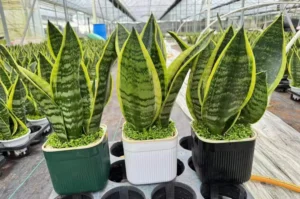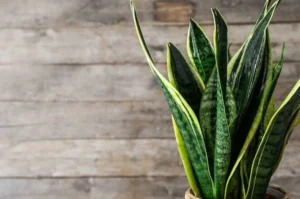The snake plant (Dracaena trifasciata), previously classified under the genus Sansevieria, is a popular houseplant known for its upright, sword-like leaves. Many people wonder whether this hardy plant falls under the category of succulents. The answer is yes! the snake plant is indeed a succulent due to its ability to store water in its thick leaves, allowing it to survive in dry conditions.
Is a Snake Plant Considered a Succulent?
Yes, snake plants are succulents. They store water in their leaves, making them drought-resistant. Plus, they thrive in low light, making them ideal for homes and offices.
What’s the Secret Behind Succulent Plants?
Succulents are plants that have adapted to arid environments by storing water in their leaves, stems, or roots. These plants generally have thick, fleshy tissues that help them survive long periods without water. They are also known for their ability to thrive in sandy, well-draining soils and require minimal maintenance.
Why the Snake Plant is Considered a Succulent
1. Water Storage in Leaves
One of the key characteristics of succulents is their ability to retain water in their leaves, and the snake plant does this exceptionally well. Its thick, fleshy leaves act as reservoirs, enabling the plant to withstand drought conditions.
2. Drought Resistance
Like other succulents, snake plants can survive with minimal watering. They do well with deep but infrequent watering, allowing the soil to dry out completely between waterings.
3. Minimal Maintenance
Succulents are generally low-maintenance plants, and the snake plant is no exception. It does not require frequent fertilization, repotting, or pruning, making it a perfect choice for beginners.
4. Well-Draining Soil
Snake plants thrive in sandy or cactus mix soils, similar to other succulents. This type of soil prevents excess water retention, reducing the risk of root rot.
5. Tolerance to Various Light Conditions
While most succulents prefer bright sunlight, snake plants can adapt to a wide range of lighting conditions, including low-light environments. This makes them unique among succulents, which typically require more direct sunlight.
How to Care for a Snake Plant
If you own a snake plant or are planning to get one, understanding its care requirements is essential to keeping it healthy.
1. Light Requirements
- Snake plants thrive in bright, indirect sunlight but can tolerate low-light conditions.
- Avoid prolonged exposure to direct sun, which can scorch the leaves.
2. Watering
- Water sparingly, allowing the soil to dry out completely before the next watering.
- Overwatering can lead to root rot, a common issue with succulents.
- Reduce watering during winter when the plant’s growth slows.
3. Soil and Potting
- Use well-draining cactus or succulent soil.
- Choose pots with drainage holes to prevent water from accumulating at the roots.
4. Temperature and Humidity
- Snake plants prefer warm temperatures between 60°F and 80°F (16°C to 27°C).
- They are not frost-tolerant, so avoid placing them in temperatures below 50°F (10°C).
5. Fertilizing
- Feed with a diluted succulent fertilizer once a month during the growing season (spring and summer).
- Avoid over-fertilizing, as this can cause weak and leggy growth.
Common Problems and Solutions
1. Yellowing Leaves
- Cause: Overwatering
- Solution: Reduce watering and ensure the soil is well-draining.
2. Mushy or Rotting Roots
- Cause: Root rot due to excessive moisture
- Solution: Trim affected roots and repot the plant in fresh, dry soil.
3. Brown Leaf Tips
- Cause: Low humidity or inconsistent watering
- Solution: Maintain a consistent watering schedule and avoid placing the plant near heating vents.
Frequently Asked Questions (FAQs):
Can snake plants survive without water for long periods?
Yes, like other succulents, snake plants can go for weeks without water due to their ability to store moisture in their leaves.
Do snake plants purify the air?
Yes, snake plants are known for their air-purifying qualities. They remove toxins such as formaldehyde and benzene from the air and even release oxygen at night, making them great bedroom plants.
Can I keep a snake plant in a low-light area?
Absolutely! Snake plants are one of the few succulents that tolerate low-light conditions, making them ideal for offices and rooms with limited natural light.
Is the snake plant toxic to pets?
Yes, snake plants contain saponins, which can be toxic to cats and dogs if ingested. Keep them out of reach of pets to avoid any health issues.
Conclusion
The snake plant is indeed a succulent due to its ability to store water, its drought resistance, and its minimal care requirements. Its adaptability to different lighting conditions and air-purifying benefits make it a fantastic houseplant choice. Whether you are a beginner or an experienced plant parent, the snake plant is an excellent addition to any home or office, offering both aesthetic and health benefits with little maintenance required.







2 thoughts on “Is the Snake Plant Really a Succulent?”
You have mentioned very interesting details ! ps nice website .
Thank you for sharing superb informations. Your website is so cool. I am impressed by the details that you have on this site. It reveals how nicely you perceive this subject. Bookmarked this web page, will come back for more articles. You, my friend, ROCK! I found simply the info I already searched everywhere and simply could not come across. What an ideal site.